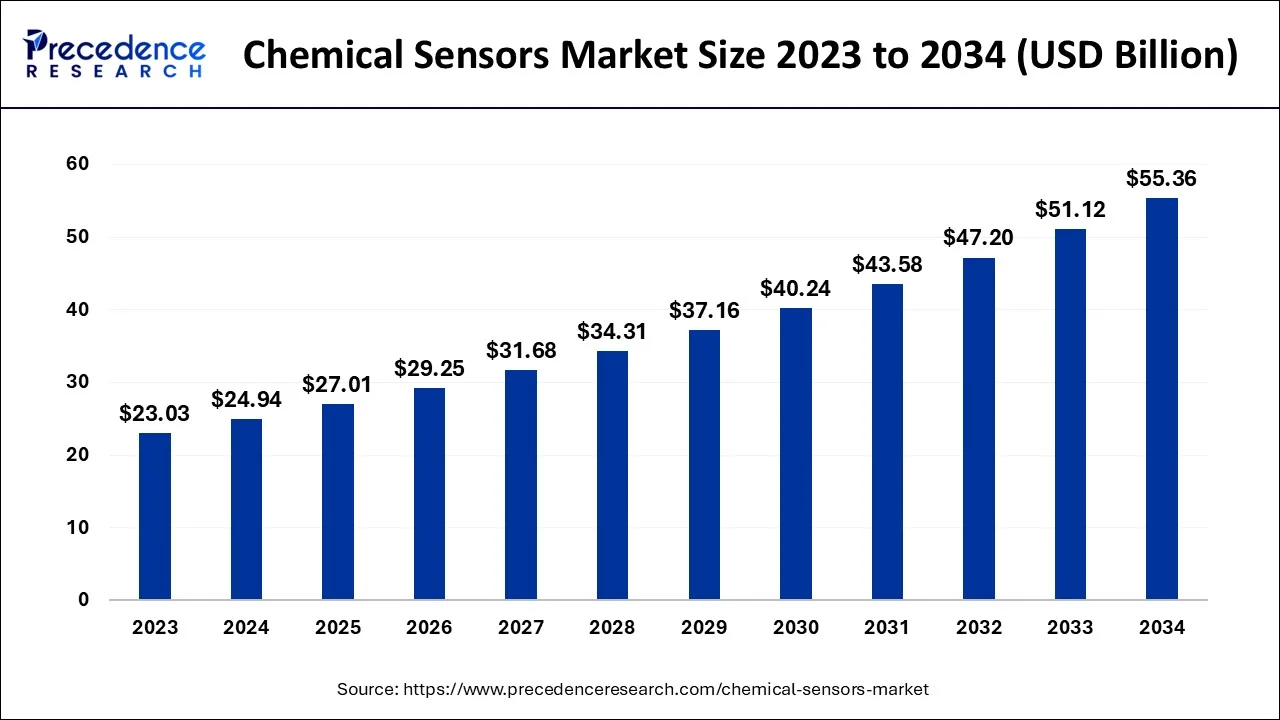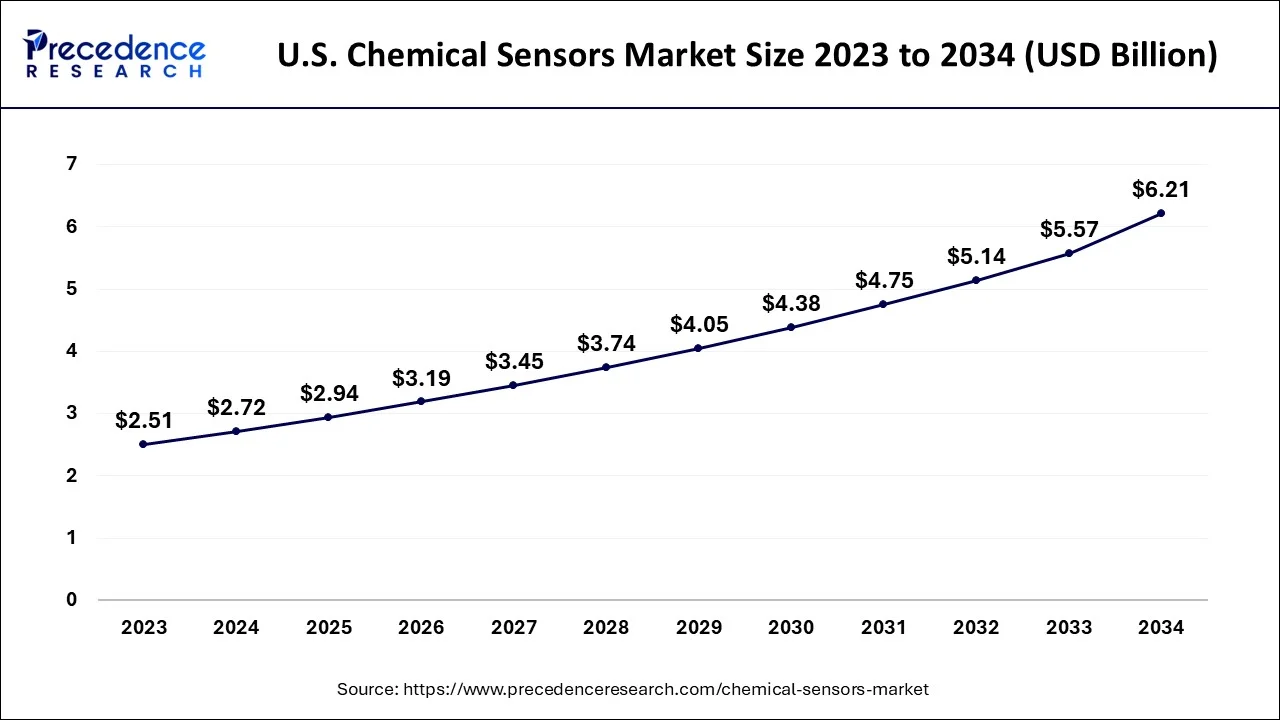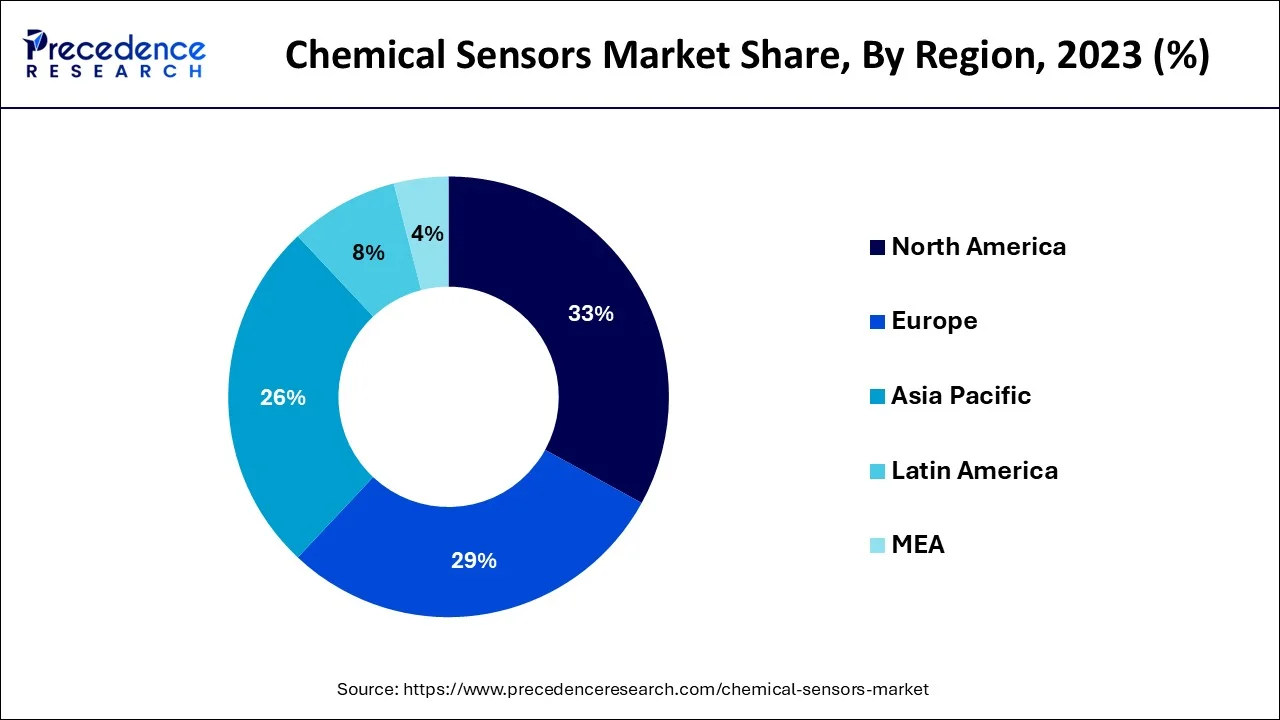December 2024
The global chemical sensors market size accounted for USD 24.94 billion in 2024, grew to USD 27.01 billion in 2025 and is predicted to surpass around USD 55.36 billion by 2034, representing a healthy CAGR of 8.30% between 2024 and 2034. The North America chemical sensors market size is calculated at USD 8.23 billion in 2024 and is expected to grow at a fastest CAGR of 8.45% during the forecast year.
The global chemical sensors market size is estimated at USD 24.94 billion in 2024 and is anticipated to reach around USD 55.36 billion by 2034, expanding at a CAGR of 8.30% from 2024 to 2034.

The U.S. chemical sensors market size is evaluated at USD 2.72 billion in 2024 and is predicted to be worth around USD 6.21 billion by 2034, rising at a CAGR of 8.58% from 2024 to 2034.

Due to the increased demand from the automobile sector, North America controls the market for chemical sensors. The primary driver of the expansion of the automobile sector is rising pollution. Additionally, rising chemical industry need for nitrogen oxide and ammonia sensors is anticipated to support the expansion of the chemical sensor market in this area. Due to the growing need for the vehicle sector, the U.S. controls the market in this area. Additionally, given that the United States emitted 71 million tonnes of pollution into the sky in 2019, air pollutants continue to be a major contributor to a number of difficulties with air quality. The deposition of particles and ozone is mostly caused by these sources.

Due to changes noticed and revolution injected in end-use sectors like the adoption of autonomous vehicles internationally, Europe and North America are likely to have significant market growth. The global market for these chemical-based sensors in Europe and North America is anticipated to grow as automakers increasingly use turbocharged engines and fuel injection. Additionally, throughout the projected period, high-cost sensors combined with rising ammonia and nitrogen oxide sensor demand to represent effective results would balance business expansion in this area.
The area of the Asia Pacific is expected to see unrestrained growth due to the expansion of the automobile and medical industries. During the projection period, it is expected that increased public awareness of health concerns, together with rising populations and vehicle sales in nations like China and India, would fuel company expansion in the region.
An analyte's chemical characteristics can be detected and measured by a chemical sensor, which then converts the chemical information into electrical information. Some of the uses for chemical sensors include oxygen, automotive sensors, the food and beverage processing industry, industrial safety and emission monitoring, the chemical processing industry, emissions monitoring, industrial safety systems, water and wastewater monitoring, environmental monitoring, defence, and homeland security. Chemical sensors are used in fertility treatments, blood sugar testing strips, portable glucose monitors, cancer detection, renal failure diagnosis, and diagnostics for drug and alcohol addiction. It is anticipated that improving diagnosis applications would encourage faster and more accurate detection processes in the medical field, which will drive the market for chemical sensors.
The driving forces behind corporate infrastructure throughout the predicted period include innovation and new innovations, as well as the use of bionic sensors like the electronic tongue and electronic nose. A crucial component of AI, these bionic sensors are utilised to mimic facial features and other body functions. The use of this technology will benefit chemical-based sensors by increasing their commercial potential.
Due to decreasing raw material costs and the use of nano- and microfabrication techniques in industrial manufacturing, the commercialization of chemical sensors for healthcare applications has significantly increased. These variables collectively create a profitable market potential for chemical sensors worldwide.
Rising adoption of centralised ventilation in homes and businesses, rising demand for optical chemical sensors used in vehicle cabin air quality systems, increasing prevalence of patients with diabetes and related disorders, expanding use of microelectronics and microfabrication technologies that require miniaturised chemical sensors, and rising number of applications from various industries are some of the crucial and important facts.
On the other hand, growing adoption of direct gasoline injection and turbocharged engines in the automotive industry, along with a in clinical diagnostics, will further contribute by generating enormous opportunities that will lead to the growth of the chemical sensors market in the previously mentioned projected timeframe.
The use of chemical sensors in analysing the chemical composition of distinct samples is influenced by applicable sensors. The chemical sensing range and orthogonal high-order sensors are significant market trends. Chemical sensors' low cost and portability are anticipated to drive market expansion. The use of chemical sensors to analyse substances is incorporated into the market alongside environmental concerns in the chemical manufacturing process. Sensors are cutting-edge equipment used by the defence sector, research labs, and health operations that in turn drive the market.
| Report Coverage | Details |
| Market Size in 2024 | USD 24.94 Billion |
| Market Size by 2034 | USD 55.36 Billion |
| Growth Rate from 2024 to 2034 | CAGR of 8.30% |
| Base Year | 2023 |
| Forecast Period | 2024 to 2034 |
| Segments Covered | Type, Particulate Type, Application, and Geography |
The rapid advancements in various industrial sectors
Chemical sensors may now be used extensively throughout industries because of product innovation
Motor vehicle market to offer best opportunities
Optical chemical sensors among fastest growing types
The market is divided into four types: electrochemical, catalytic beads, and optical sensors. The optical sensor market share is substantial. Optical chemical sensors are integrated analytical systems based on optical transduction. These devices allow for the measurement of chemicals by interacting light with a chemical system and then translating the optical signal that results into an electrical signal.
The market is divided into industrial, environmental monitoring, medical, defence and homeland security, and others based on application. The largest market share belongs to the medical sector. Therefore, some of the sensors used in medical devices are those for pressure, airflow, force, pulse oximetry, oxygen, temperature, and barcode sensing.
By Type
By Particulate Type
By Application
By Geography
For inquiries regarding discounts, bulk purchases, or customization requests, please contact us at sales@precedenceresearch.com
No cookie-cutter, only authentic analysis – take the 1st step to become a Precedence Research client
December 2024
March 2025
July 2024
January 2025